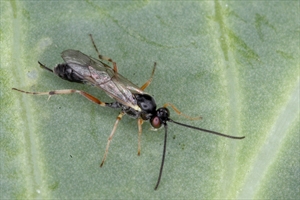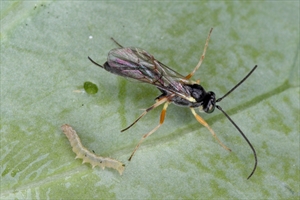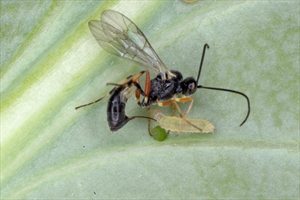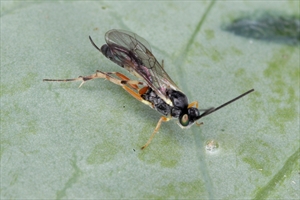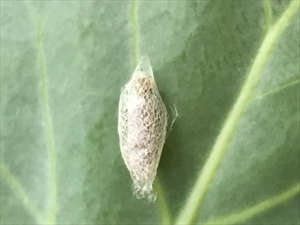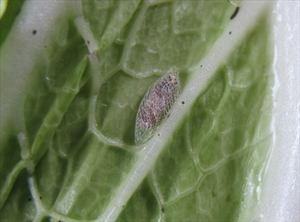- Worldwide distribution. Diadegma semiclausum is native to Europe, but introduced into many countries in Asia, Africa and Oceania. It is established in Australia and New Zealand but, not in other Pacific islands, with the exception of the highlands of Papua New Guinea.
- Common parasitising diamondback moth (DBM) caterpillars. Prefers young ones, laying one egg in each. Females lay many hundreds of eggs.
- Prefers cool temperature of 15-25°C. Look for small (6-7 mm) wasp searching on DBM-damaged leaves.
- The DBM caterpillar develops normally until it pupates, then Diadegma makes its own pupa. Look for oval pupa. 8-10 days later, adult hatches. Gives good control (if no broad-spectrum insecticides used): >90%. Do not use pyrethroids or organophosphates, as they will kill Diadegma and predators; use Bt (Bacillus thiringiensis).
Pacific Pests, Pathogens and Weeds - Online edition
Pacific Pests, Pathogens, Weeds & Pesticides
Diadegma species (285)
Parasitic wasp
Diadegma semiclausum, an ichneumonid (previously known as Diadegma euerophaga, Diadegma xylostellae, Angita cerophaga). The wasps belong to the family Ichneumonidae.
AUTHORS Mike Furlong and Grahame Jackson
Information from Biological Services, Loxton, Australia. (https://biologicalservices.com.au/products/diadegma-20.html); and CABI (2019) Diadegma. Crop Protectiion Compendium. (https://www.cabi.org/cpc/datasheet/18644); and from CABI (2019) Diadegma semiclausum. Crop Protectiion Compendium. (https://www.cabi.org/cpc/datasheet/18678).
Produced with support from the Australian Centre for International Agricultural Research under project PC/2010/090: Strengthening integrated crop management research in the Pacific Islands in support of sustainable intensification of high-value crop production, implemented by the University of Queensland and the Secretariat of the Pacific Community.
